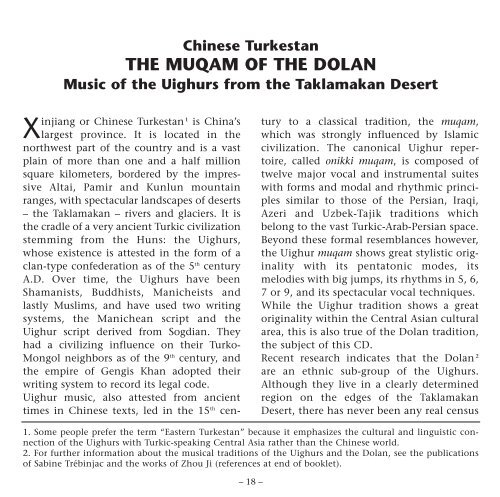Turkestan chinois, LE MUQAM DES DOLAN - Document sans titre ...
Turkestan chinois, LE MUQAM DES DOLAN - Document sans titre ...
Turkestan chinois, LE MUQAM DES DOLAN - Document sans titre ...
Create successful ePaper yourself
Turn your PDF publications into a flip-book with our unique Google optimized e-Paper software.
Chinese <strong>Turkestan</strong><br />
THE <strong>MUQAM</strong> OF THE <strong>DOLAN</strong><br />
Music of the Uighurs from the Taklamakan Desert<br />
X injiang or Chinese <strong>Turkestan</strong> 1 is China’s<br />
largest province. It is located in the<br />
northwest part of the country and is a vast<br />
plain of more than one and a half million<br />
square kilometers, bordered by the impressive<br />
Altai, Pamir and Kunlun mountain<br />
ranges, with spectacular landscapes of deserts<br />
– the Taklamakan – rivers and glaciers. It is<br />
the cradle of a very ancient Turkic civilization<br />
stemming from the Huns: the Uighurs,<br />
whose existence is attested in the form of a<br />
clan-type confederation as of the 5 th century<br />
A.D. Over time, the Uighurs have been<br />
Shamanists, Buddhists, Manicheists and<br />
lastly Muslims, and have used two writing<br />
systems, the Manichean script and the<br />
Uighur script derived from Sogdian. They<br />
had a civilizing influence on their Turko-<br />
Mongol neighbors as of the 9 th century, and<br />
the empire of Gengis Khan adopted their<br />
writing system to record its legal code.<br />
Uighur music, also attested from ancient<br />
times in Chinese texts, led in the 15 th cen-<br />
– 18 –<br />
tury to a classical tradition, the muqam,<br />
which was strongly influenced by Islamic<br />
civilization. The canonical Uighur repertoire,<br />
called onikki muqam, is composed of<br />
twelve major vocal and instrumental suites<br />
with forms and modal and rhythmic principles<br />
similar to those of the Persian, Iraqi,<br />
Azeri and Uzbek-Tajik traditions which<br />
belong to the vast Turkic-Arab-Persian space.<br />
Beyond these formal resemblances however,<br />
the Uighur muqam shows great stylistic originality<br />
with its pentatonic modes, its<br />
melodies with big jumps, its rhythms in 5, 6,<br />
7 or 9, and its spectacular vocal techniques.<br />
While the Uighur tradition shows a great<br />
originality within the Central Asian cultural<br />
area, this is also true of the Dolan tradition,<br />
the subject of this CD.<br />
Recent research indicates that the Dolan 2<br />
are an ethnic sub-group of the Uighurs.<br />
Although they live in a clearly determined<br />
region on the edges of the Taklamakan<br />
Desert, there has never been any real census<br />
1. Some people prefer the term “Eastern <strong>Turkestan</strong>” because it emphasizes the cultural and linguistic connection<br />
of the Uighurs with Turkic-speaking Central Asia rather than the Chinese world.<br />
2. For further information about the musical traditions of the Uighurs and the Dolan, see the publications<br />
of Sabine Trébinjac and the works of Zhou Ji (references at end of booklet).



